Coat Color Genetics
You can also see the different colors as they grow on this page.
To date, there are at least ten known loci that control coat color in gerbils; each locus controls a different trait. Each of these loci has a dominant allele, that usually represents the form of the trait commonly found in the wild, and at least one recessive allele, representing a less common form of the trait. The eight loci discussed on this page are: A, C, D, E, P, Uw, Sp, and Re. I will also touch on Steel-factor, which is a different sort of locus. The loci not discussed include the Semi-Dominant Lethal Spotting and Wavy mutations, which are not known to be present in the USA at this point.
To understand how these loci work, it is necessary to know how color is structured on the hair.

B: The middle band is a golden brown. Because of the way the individual hairs of the coat overlap, this middle band is the most visible, and contributes most to the perceived overall color.
C: The tip of the hair is black, which gives rise to "ticking", the stippled appearance of colors such as Agouti and Nutmeg.
This gray-brown-black pattern causes the wild-colored coat to appear a dark brown.
Navigation
| A-locus | C-locus | D-locus | E-locus | P-locus | Uw-locus | Sp-locus | Re-locus | Steel-factor |
The Re-locus: Rexoid
The Rexoid locus is unique among the loci discussed here, as it controls fur structure rather than color. Rex (Re) is a dominant mutation, so just like in the Sp-locus, the wild-type allele is written as + rather than re. One copy of the Rex allele (Re+) produces a gerbil with a thick, curly coat. The coat density and curl tends to change with every molt. Overall, the fur tends to straighten with age, as do the whiskers.
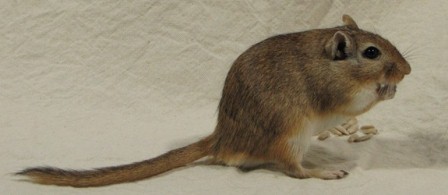
A- C- D- E- P- Uw- ++ :: Agouti (standard coat)
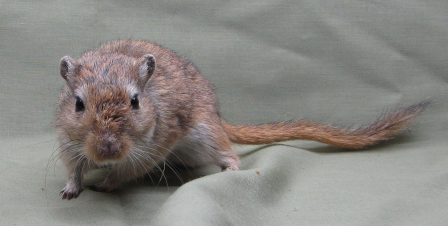
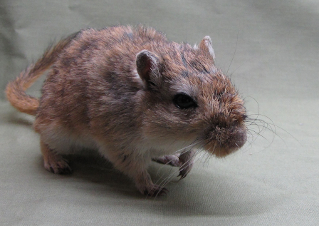
A- C- D- E- P- Uw- Re+ :: Agouti Rex
Two copies of the Rex allele (ReRe) gives a double rex, or drex. Drexes have an even curlier coat, but the hairs are fragile, breaking off at the slightest provocation. From one molt to the next, a drex can go from a full, tightly-curled coat to being nearly bald. Drexes suffer from multiple health issues, including eye injuries and infections due to lashes curling towards the surface of the eye, and lower life expectancy in general (around 18 months).
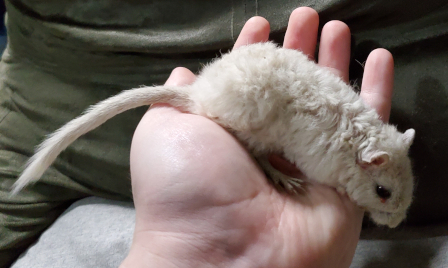
A- C- D- ee P- uwduwd ReRe :: Polar Fox Double Rex (13 months old)
Left to right: Polar Fox Drex, Polar Fox Rex, Agouti Drex (2 weeks old)
Because of the health problems with drex, it's recommended to breed rex-to-standard, not rex-to-rex. Both ways still give a 50% chance of rex in the pups.
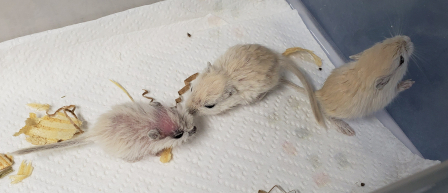
Left to right: Polar Fox Drex, Polar Fox Rex, Polar Fox standard coat (3.4 weeks old)
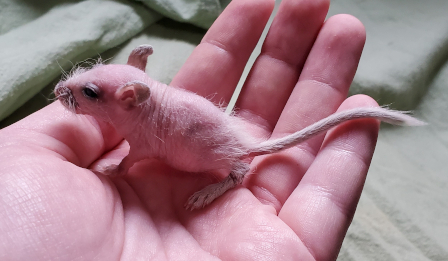
Polar Fox Drex, nearly hairless at 4.7 weeks old
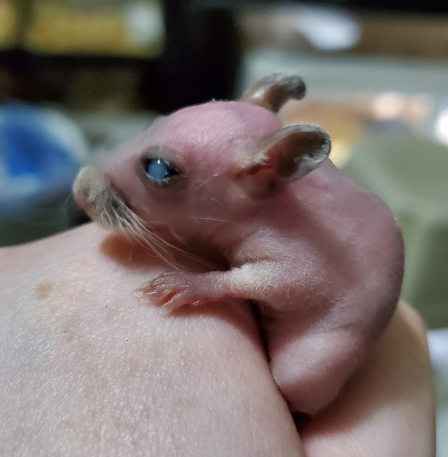
Polar Fox Drex, with cataract and conjunctivitis at 5.3 weeks old

Unless otherwise specified, all text and images at this site are licensed under a
Creative Commons Attribution-Noncommercial-Share Alike 3.0 United States License